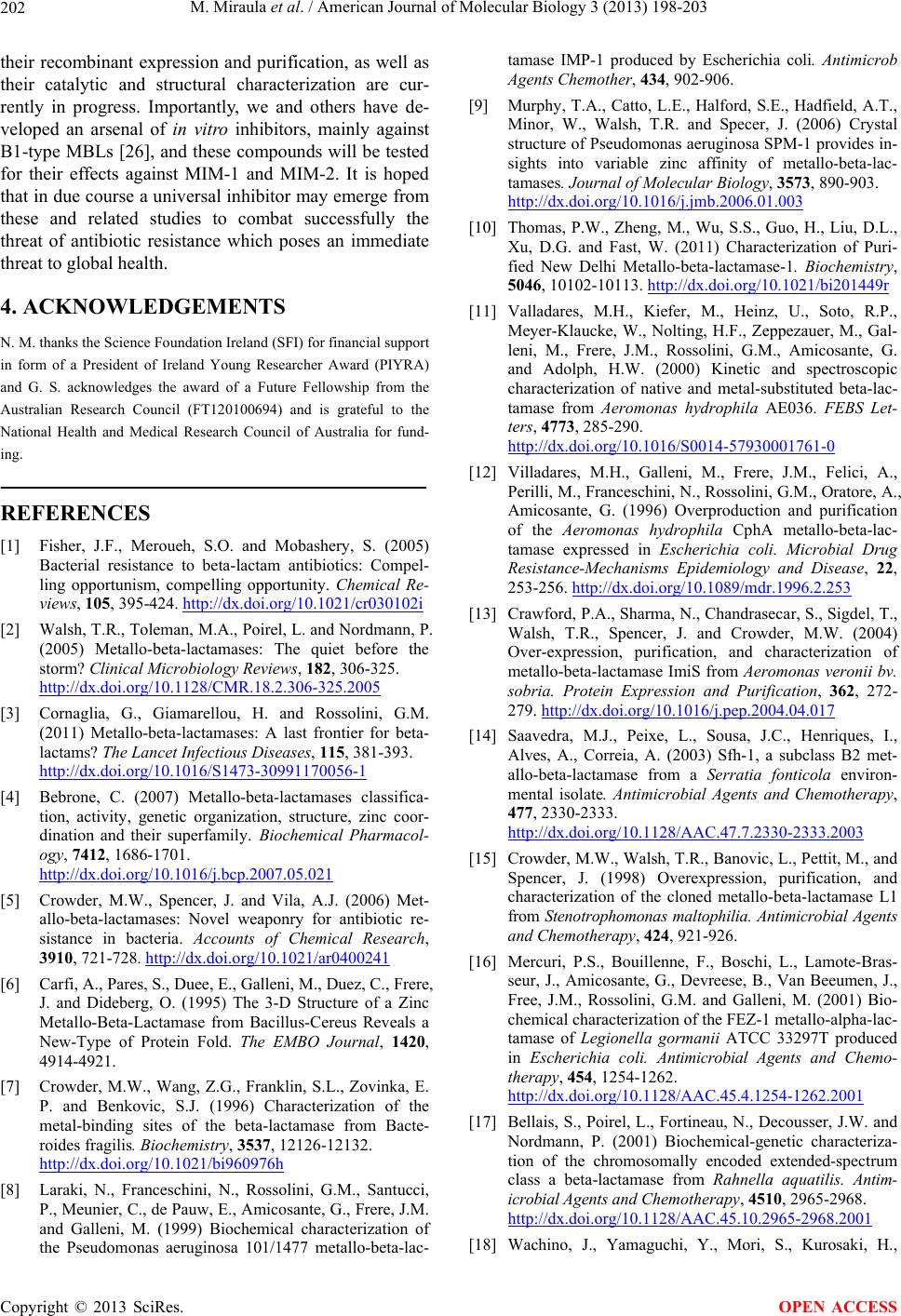
M. Miraula et al. / American Journal of Molecular Biology 3 (2013) 198-203
202
their recombinant expression and purification, as well as
their catalytic and structural characterization are cur-
rently in progress. Importantly, we and others have de-
veloped an arsenal of in vitro inhibitors, mainly against
B1-type MBLs [26], and these compounds will be tested
for their effects against MIM-1 and MIM-2. It is hoped
that in due course a universal inhibitor may emerge from
these and related studies to combat successfully the
threat of antibiotic resistance which poses an immediate
threat to global health.
4. ACKNOWLEDGEMENTS
N. M. thanks the Science Foundation Ireland (SFI) for financial support
in form of a President of Ireland Young Researcher Award (PIYRA)
and G. S. acknowledges the award of a Future Fellowship from the
Australian Research Council (FT120100694) and is grateful to the
National Health and Medical Research Council of Australia for fund-
ing.
REFERENCES
[1] Fisher, J.F., Meroueh, S.O. and Mobashery, S. (2005)
Bacterial resistance to beta-lactam antibiotics: Compel-
ling opportunism, compelling opportunity. Chemical Re-
views, 105, 395-424. http://dx.doi.org/10.1021/cr030102i
[2] Walsh, T.R., Toleman, M.A., Poirel, L. and Nordmann, P.
(2005) Metallo-beta-lactamases: The quiet before the
storm? Clinical Microbiology Reviews, 182, 306-325.
http://dx.doi.org/10.1128/CMR.18.2.306-325.2005
[3] Cornaglia, G., Giamarellou, H. and Rossolini, G.M.
(2011) Metallo-beta-lactamases: A last frontier for beta-
lactams? The Lancet Infectious Diseases, 115, 381-393.
http://dx.doi.org/10.1016/S1473-30991170056-1
[4] Bebrone, C. (2007) Metallo-beta-lactamases classifica-
tion, activity, genetic organization, structure, zinc coor-
dination and their superfamily. Biochemical Pharmacol-
ogy, 7412, 1686-1701.
http://dx.doi.org/10.1016/j.bcp.2007.05.021
[5] Crowder, M.W., Spencer, J. and Vila, A.J. (2006) Met-
allo-beta-lactamases: Novel weaponry for antibiotic re-
sistance in bacteria. Accounts of Chemical Research,
3910, 721-728. http://dx.doi.org/10.1021/ar0400241
[6] Carfi, A., Pares, S., Duee, E., Galleni, M., Duez, C., Frere,
J. and Dideberg, O. (1995) The 3-D Structure of a Zinc
Metallo-Beta-Lactamase from Bacillus-Cereus Reveals a
New-Type of Protein Fold. The EMBO Journal, 1420,
4914-4921.
[7] Crowder, M.W., Wang, Z.G., Franklin, S.L., Zovinka, E.
P. and Benkovic, S.J. (1996) Characterization of the
metal-binding sites of the beta-lactamase from Bacte-
roides fragilis. Biochemistry, 3537, 12126-12132.
http://dx.doi.org/10.1021/bi960976h
[8] Laraki, N., Franceschini, N., Rossolini, G.M., Santucci,
P., Meunier, C., de Pauw, E., Amicosante, G., Frere, J.M.
and Galleni, M. (1999) Biochemical characterization of
the Pseudomonas aeruginosa 101/1477 metallo-beta-lac-
tamase IMP-1 produced by Escherichia coli. Antimicrob
Agents Chemother, 434, 902-906.
[9] Murphy, T.A., Catto, L.E., Halford, S.E., Hadfield, A.T.,
Minor, W., Walsh, T.R. and Specer, J. (2006) Crystal
structure of Pseudomonas aeruginosa SPM-1 provides in-
sights into variable zinc affinity of metallo-beta-lac-
tamases. Journal of Molecular Biology, 3573, 890-903.
http://dx.doi.org/10.1016/j.jmb.2006.01.003
[10] Thomas, P.W., Zheng, M., Wu, S.S., Guo, H., Liu, D.L.,
Xu, D.G. and Fast, W. (2011) Characterization of Puri-
fied New Delhi Metallo-beta-lactamase-1. Biochemistry,
5046, 10102-10113. http://dx.doi.org/10.1021/bi201449r
[11] Valladares, M.H., Kiefer, M., Heinz, U., Soto, R.P.,
Meyer-Klaucke, W., Nolting, H.F., Zeppezauer, M., Gal-
leni, M., Frere, J.M., Rossolini, G.M., Amicosante, G.
and Adolph, H.W. (2000) Kinetic and spectroscopic
characterization of native and metal-substituted beta-lac-
tamase from Aeromonas hydrophila AE036. FEBS Let-
ters, 4773, 285-290.
http://dx.doi.org/10.1016/S0014-57930001761-0
[12] Villadares, M.H., Galleni, M., Frere, J.M., Felici, A.,
Perilli, M., Franceschini, N., Rossolini, G.M., Oratore, A.,
Amicosante, G. (1996) Overproduction and purification
of the Aeromonas hydrophila CphA metallo-beta-lac-
tamase expressed in Escherichia coli. Microbial Drug
Resistance-Mechanisms Epidemiology and Disease, 22,
253-256. http://dx.doi.org/10.1089/mdr.1996.2.253
[13] Crawford, P.A., Sharma, N., Chandrasecar, S., Sigdel, T.,
Walsh, T.R., Spencer, J. and Crowder, M.W. (2004)
Over-expression, purification, and characterization of
metallo-beta-lactamase ImiS from Aeromonas veronii bv.
sobria. Protein Expression and Purification, 362, 272-
279. http://dx.doi.org/10.1016/j.pep.2004.04.017
[14] Saavedra, M.J., Peixe, L., Sousa, J.C., Henriques, I.,
Alves, A., Correia, A. (2003) Sfh-1, a subclass B2 met-
allo-beta-lactamase from a Serratia fonticola environ-
mental isolate. Antimicrobial Agents and Chemotherapy,
477, 2330-2333.
http://dx.doi.org/10.1128/AAC.47.7.2330-2333.2003
[15] Crowder, M.W., Walsh, T.R., Banovic, L., Pettit, M., and
Spencer, J. (1998) Overexpression, purification, and
characterization of the cloned metallo-beta-lactamase L1
from Stenotrophomonas maltophilia. Antimicrobial Agents
and Chemotherapy, 424, 921-926.
[16] Mercuri, P.S., Bouillenne, F., Boschi, L., Lamote-Bras-
seur, J., Amicosante, G., Devreese, B., Van Beeumen, J.,
Free, J.M., Rossolini, G.M. and Galleni, M. (2001) Bio-
chemical characterization of the FEZ-1 metallo-alpha-lac-
tamase of Legionella gormanii ATCC 33297T produced
in Escherichia coli. Antimicrobial Agents and Chemo-
therapy, 454, 1254-1262.
http://dx.doi.org/10.1128/AAC.45.4.1254-1262.2001
[17] Bellais, S., Poirel, L., Fortineau, N., Decousser, J.W. and
Nordmann, P. (2001) Biochemical-genetic characteriza-
tion of the chromosomally encoded extended-spectrum
class a beta-lactamase from Rahnella aquatilis. Antim-
icrobial Agents and Chemotherapy, 4510, 2965-2968.
http://dx.doi.org/10.1128/AAC.45.10.2965-2968.2001
[18] Wachino, J., Yamaguchi, Y., Mori, S., Kurosaki, H.,
Copyright © 2013 SciRes. OPEN ACCESS